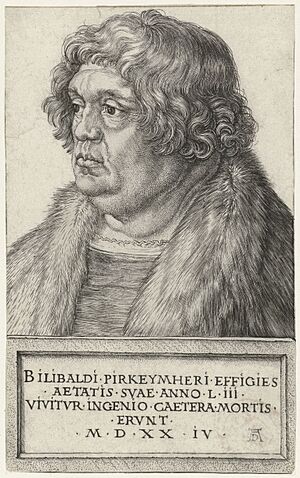Willibald Pirckheimer facts for kids
Quick facts for kids
Willibald Pirckheimer
|
|
|---|---|

Engraving of Willibald Pirckheimer at 53 by Albrecht Dürer, 1524. We live by the spirit. The rest belongs to death.
|
|
| Born | 5 December 1470 Eichstätt, Bishopric of Eichstätt
|
| Died | 22 December 1530 (aged 60) |
| Occupation | Lawyer |
| Relatives | Willibald Imhoff (grandson) |
Willibald Pirckheimer (born December 5, 1470 – died December 22, 1530) was an important person in Nuremberg, Germany, during the 16th century. He was a lawyer, a writer, and a Renaissance humanist. This means he was very interested in the ideas and art from ancient Greece and Rome.
Pirckheimer was a wealthy and well-known figure. He was also an advisor to the Emperor and served on the city council of Nuremberg. He was a great supporter of arts and learning. He was also a very close friend of the famous artist Albrecht Dürer.
Contents
Early Life and Education
Willibald Pirckheimer was born in Eichstätt, a city in Germany. His father, Dr. Johannes Pirckheimer, was also a lawyer. Willibald studied law in Italy for seven years. He attended universities in Padua and Pavia.
He had a wife named Cresencia and at least one daughter, Felicitas. His older sister, Caritas Pirckheimer, was also very smart. She was the head of a convent (a place where nuns live) in Nuremberg. This convent also served as a school for girls from important families. Caritas was also a skilled scholar of ancient languages.
Friendships and Influence
Pirckheimer was part of a group of smart people in Nuremberg called humanists. This group included Conrad Celtis and Hartmann Schedel, who wrote the famous Nuremberg Chronicle.
He was also an advisor to Maximilian I, Holy Roman Emperor, on matters of literature. Pirckheimer translated many old texts from Greek and Latin into German. He believed in translating the meaning of the text, not just word-for-word. In 1525, he helped publish a version of Ptolemy's Geography, an ancient book about maps and places.
Friendship with Albrecht Dürer
Pirckheimer and the artist Albrecht Dürer became close friends around 1495. Dürer did not have a classical education like Pirckheimer. So, it is believed that Pirckheimer helped Dürer understand many ideas from ancient times. These ideas often appeared in Dürer's famous artworks, especially his prints. A good example is Dürer's engraving called Melencolia I.
Pirckheimer even lent Dürer money for his second trip to Italy in 1506. Letters from Dürer to Pirckheimer show how close their friendship was. They often teased each other in their letters.
Military Service
In 1499, the city council of Nuremberg chose Pirckheimer to lead their soldiers. These troops joined the Emperor's army during the Swabian War against the Swiss. When he returned, the city gave him a special gold cup. This event might be shown in Dürer's engraving Nemesis, made around 1502.
Supporting Other Scholars
Pirckheimer also supported other smart people. He was a patron (a supporter) of Johannes Werner, who studied stars and weather. Werner used Pirckheimer's help to create tools and conduct experiments. He measured distances, studied the Earth's magnetism, and observed the weather.
Later Life and Legacy
Willibald Pirckheimer died in Nuremberg when he was 60 years old. He is buried in the Johannisfriedhof cemetery in Nuremberg, just like his friend Dürer.
Pirckheimer had a very famous library of books. After Dürer's family line ended in 1560, Pirckheimer's grandson, Willibald Imhoff, bought Dürer's remaining art collections and papers. Much of Pirckheimer's own library was later sold to the Earl of Arundel in 1636. Some of these books are now in the Royal Society in London.
Pirckheimer's portrait even appeared on a 100 Billion Mark note during Germany's Weimar Republic. This shows how important he was in German history.

